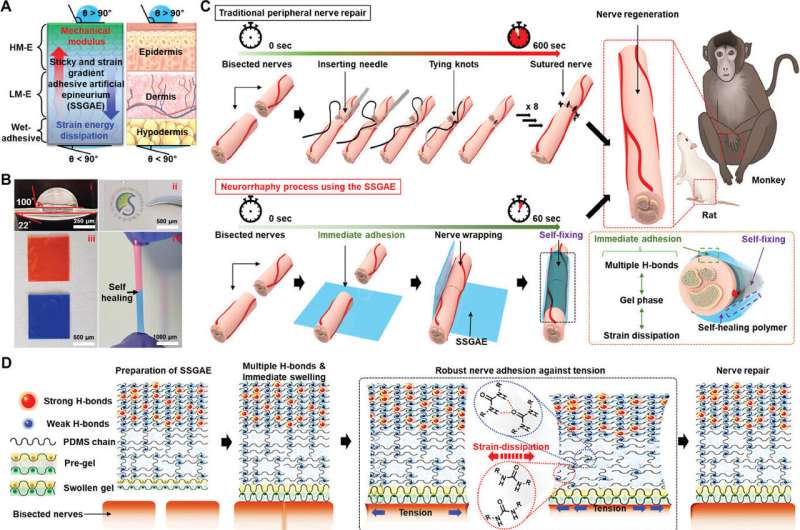This article has been reviewed according to Science X's editorial process and policies. Editors have highlighted the following attributes while ensuring the content's credibility:
fact-checked
peer-reviewed publication
proofread
'Sticky and strain-gradient artificial epineurium' can heal severed nerves in only one minute, study claims

A novel medical advancement termed the "sticky and strain-gradient artificial epineurium" (SSGAE) has been developed, demonstrating remarkable efficacy in rapidly healing severed nerves without traditional microsurgical suturing techniques.
This innovation, spearheaded by a collaborative effort between Professor Jong Woong Park from Orthopedic Surgery, Korea University College of Medicine, Professor Donghee Son from Sungkyunkwan University Department of Superintelligence Engineering, and Professor Mikyung Shin from the Department of Biomedical Engineering, presents a significant breakthrough in nerve repair surgery.
A paper describing this work is published in the journal Advanced Materials.
The SSGAE, designed to mimic the structural properties of human skin while possessing strong tissue adhesive capabilities, provides a sutureless alternative for traditional neurorrhaphy. By enveloping the site of nerve rupture like a bandage, this cutting-edge neural patch facilitates the process of neurorrhaphy rapidly and easily, eliminating the need for intricate microsurgical techniques that previously could only be performed by a well-trained microsurgeon. Consequently, it enhances the success rate of nerve injury treatments.
Inspired by the complex layered structure of the human skin, the SSGAE employs self-healing polymers and adhesive hydrogels to achieve robust adhesion and resilience. Through meticulous engineering, this neural patch combines properties of elasticity and viscosity, ensuring uniform dispersion of external pressures while effectively absorbing stress. Self-healing polymers are smart materials that autonomously detect and mend their structural defects when they sustain physical damage.
The transformative potential of the SSGAE lies in its ability to simplify nerve repair procedures, alleviating the demand for highly specialized microsurgeons and reducing operative times significantly. Experimental validation, including studies conducted on small animal models, confirms the expedited healing process facilitated by the SSGAE, with neurorrhaphy accomplished in as little as one minute.
Notably, validation experiments utilizing the median nerve injury model of a primate have demonstrated substantial nerve regeneration and functional recovery following nerve repair with the SSGAE, underscoring its superiority over conventional suturing methods.
After a year of follow-up, the primate's thumb movement had almost completely recovered. Moreover, the incorporation of nerve-regenerating proteins into the SSGAE has shown promise in expediting tissue regeneration, offering a potential avenue for enhancing patient outcomes.
More information: Duhwan Seong et al, Sticky and Strain‐Gradient Artificial Epineurium for Sutureless Nerve Repair in Rodents and Nonhuman Primates, Advanced Materials (2024). DOI: 10.1002/adma.202307810




















